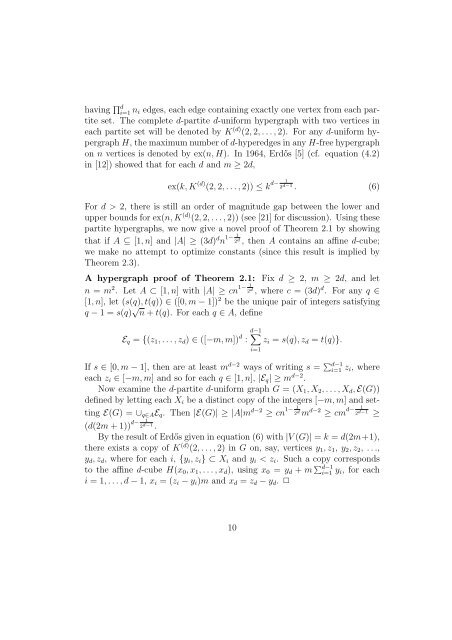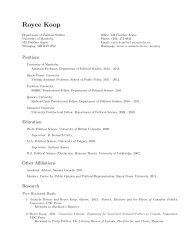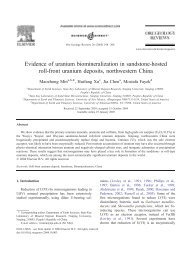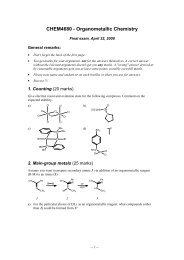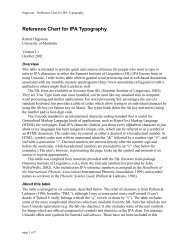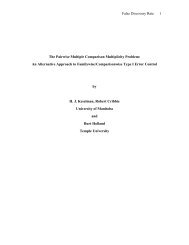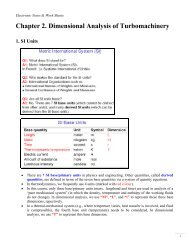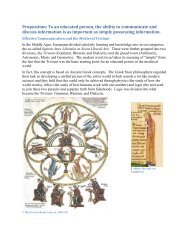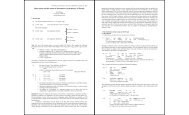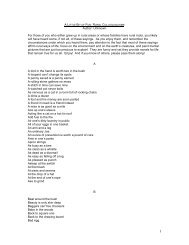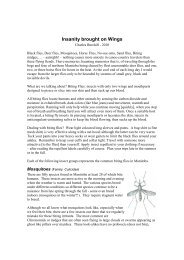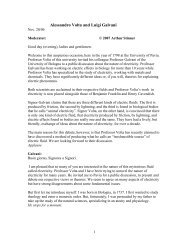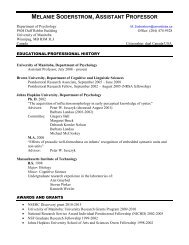Extremal problems for affine cubes of integers - University of Manitoba
Extremal problems for affine cubes of integers - University of Manitoba
Extremal problems for affine cubes of integers - University of Manitoba
Create successful ePaper yourself
Turn your PDF publications into a flip-book with our unique Google optimized e-Paper software.
having d i=1 ni edges, each edge containing exactly one vertex from each partite<br />
set. The complete d-partite d-uni<strong>for</strong>m hypergraph with two vertices in<br />
each partite set will be denoted by K (d) (2, 2, . . . , 2). For any d-uni<strong>for</strong>m hypergraph<br />
H, the maximum number <strong>of</strong> d-hyperedges in any H-free hypergraph<br />
on n vertices is denoted by ex(n, H). In 1964, Erdős [5] (cf. equation (4.2)<br />
in [12]) showed that <strong>for</strong> each d and m ≥ 2d,<br />
ex(k, K (d) 1<br />
d−<br />
(2, 2, . . . , 2)) ≤ k 2d−1 . (6)<br />
For d > 2, there is still an order <strong>of</strong> magnitude gap between the lower and<br />
upper bounds <strong>for</strong> ex(n, K (d) (2, 2, . . . , 2)) (see [21] <strong>for</strong> discussion). Using these<br />
partite hypergraphs, we now give a novel pro<strong>of</strong> <strong>of</strong> Theorem 2.1 by showing<br />
that if A ⊆ [1, n] and |A| ≥ (3d) d 1<br />
1−<br />
n 2d , then A contains an <strong>affine</strong> d-cube;<br />
we make no attempt to optimize constants (since this result is implied by<br />
Theorem 2.3).<br />
A hypergraph pro<strong>of</strong> <strong>of</strong> Theorem 2.1: Fix d ≥ 2, m ≥ 2d, and let<br />
n = m2 1<br />
1−<br />
. Let A ⊂ [1, n] with |A| ≥ cn 2d , where c = (3d) d . For any q ∈<br />
[1, n], let (s(q), t(q)) ∈ ([0, m − 1]) 2 be the unique pair <strong>of</strong> <strong>integers</strong> satisfying<br />
q − 1 = s(q) √ n + t(q). For each q ∈ A, define<br />
d−1<br />
Eq = {(z1, . . . , zd) ∈ ([−m, m]) d <br />
: zi = s(q), zd = t(q)}.<br />
If s ∈ [0, m − 1], then are at least md−2 ways <strong>of</strong> writing s = d−1 i=1 zi, where<br />
each zi ∈ [−m, m] and so <strong>for</strong> each q ∈ [1, n], |Eq| ≥ md−2 .<br />
Now examine the d-partite d-uni<strong>for</strong>m graph G = (X1, X2, . . . , Xd, E(G))<br />
defined by letting each Xi be a distinct copy <strong>of</strong> the <strong>integers</strong> [−m, m] and setting<br />
E(G) = ∪q∈AEq. Then |E(G)| ≥ |A|md−2 1<br />
1−<br />
≥ cn 2d md−2 1<br />
d−<br />
≥ cm 2d−1 ≥<br />
1<br />
d−<br />
(d(2m + 1)) 2d−1 .<br />
By the result <strong>of</strong> Erdős given in equation (6) with |V (G)| = k = d(2m+1),<br />
there exists a copy <strong>of</strong> K (d) (2, . . . , 2) in G on, say, vertices y1, z1, y2, z2, . . .,<br />
yd, zd, where <strong>for</strong> each i, {yi, zi} ⊂ Xi and yi < zi. Such a copy corresponds<br />
to the <strong>affine</strong> d-cube H(x0, x1, . . . , xd), using x0 = yd + m d−1 i=1 yi, <strong>for</strong> each<br />
i = 1, . . . , d − 1, xi = (zi − yi)m and xd = zd − yd. ✷<br />
10<br />
i=1


